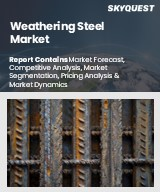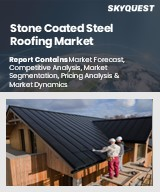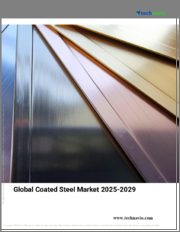
|
시장보고서
상품코드
1772731
내후성강 시장 규모, 점유율, 성장 분석 : 유형별, 형상별, 가용성별, 최종 용도 산업별, 지역별 - 산업 예측(2025-2032년)Weathering Steel Market Size, Share, and Growth Analysis, By Type (Corten-A, Corten-B), By Form (Plates, Sheets), By Availability, By End Use Industry, By Region - Industry Forecast 2025-2032 |
||||||
세계의 내후성강 시장 규모는 2023년에 20억 달러로 평가되며, 예측 기간(2025-2032년)의 CAGR은 8.1%로, 2024년 21억 6,000만 달러에서 2032년까지 40억 3,000만 달러로 성장할 전망입니다.
세계 내후성 철강 시장은 인프라 개발의 강화와 산업 장비 제조에서 철강에 대한 의존도가 높아짐에 따라 급성장하고 있습니다. 특히 내식성이 중요한 교량, 고속도로, 철도 등에서는 내구성과 미적 품질이 현대 건설에 필수적인 요소입니다. 이 소재는 특히 북미와 유럽에서 두드러지게 나타나는 지속가능성과 미니멀한 건축 디자인에 대한 관심 증가와 일치합니다. 광업 및 발전과 같은 중공업에서는 혹독한 환경 조건을 견디는 장비에 내후성 강재를 선호합니다. 그러나 높은 초기 비용, 습한 기후에서의 효과 한계, 미적 제약, 규제 장벽, 신흥 시장에서의 낮은 인지도 등의 문제는 장기적으로 시장 성장을 저해할 수 있습니다. 전반적으로 볼 때, 인프라가 발전함에 따라 내후성 강철의 잠재력은 여전히 높습니다.
목차
서론
- 조사의 목적
- 조사 범위
- 정의
조사 방법
- 정보 조달
- 2차와 1차 데이터 방법
- 시장 규모 예측
- 시장의 전제조건과 제한
개요
- 세계 시장 전망
- 공급과 수요 동향 분석
- 부문별 기회 분석
시장 역학과 전망
- 시장 개요
- 시장 규모
- 시장 역학
- 촉진요인과 기회
- 억제요인과 과제
- Porter의 산업 분석
주요 시장 인사이트
- 주요 성공 요인
- 경쟁의 정도
- 주요 투자 기회
- 시장 에코시스템
- 시장의 매력 지수(2024년)
- PESTEL 분석
- 거시경제 지표
- 밸류체인 분석
- 가격 분석
세계의 내후성강 시장 규모 : 유형별·CAGR(2025-2032년)
- 시장 개요
- Corten-A
- Corten-B
- 기타(A604, A606 등)
세계의 내후성강 시장 규모 : 형상별·CAGR(2025-2032년)
- 시장 개요
- 플레이트
- 시트
- 바
- 기타(코일, 리벳, 스트라이프, 튜브 등)
세계의 내후성강 시장 규모 : 가용성별·CAGR(2025-2032년)
- 시장 개요
- 페인티드
- 언페인티드
세계의 내후성강 시장 규모 : 최종 용도 산업별·CAGR(2025-2032년)
- 시장 개요
- 건축·건설
- 교통기관
- 예술·아키텍처
- 산업
- 기타(장식품, 가로등 등)
세계의 내후성강 시장 규모·CAGR(2025-2032년)
- 북미
- 미국
- 캐나다
- 유럽
- 독일
- 스페인
- 프랑스
- 영국
- 이탈리아
- 기타 유럽 지역
- 아시아태평양
- 중국
- 인도
- 일본
- 한국
- 기타 아시아태평양
- 라틴아메리카
- 브라질
- 기타 라틴아메리카 지역
- 중동 및 아프리카
- GCC 국가
- 남아프리카공화국
- 기타 중동 및 아프리카
경쟁 정보
- 상위 5사의 비교
- 주요 기업의 시장 포지셔닝(2024년)
- 주요 시장 기업이 채택한 전략
- 최근 시장 동향
- 기업의 시장 점유율 분석(2024년)
- 주요 기업의 기업 개요
- 기업의 상세
- 제품 포트폴리오 분석
- 기업의 부문별 점유율 분석
- 매출의 전년대비 비교(2022-2024년)
주요 기업 개요
- ArcelorMittal(Germany/Luxembourg)
- Nippon Steel Corporation(Japan)
- Tata Steel(India)
- POSCO(South Korea)
- SSAB AB(Sweden)
- JFE Steel Corporation(Japan)
- BlueScope Steel Limited(Australia)
- HBIS Group(China)
- Zahner Company(USA)
- Wugang Group(China)
- Rautaruukki Corporation(Finland)
- Leeco Steel(USA)
- Nucor Corporation(USA)
- Ansteel Group Corporation(China)
- Baosteel Group(China)
- Wuhan Iron and Steel Corporation(China)
- Metal Sales Manufacturing Corporation(USA)
- Ternium S.A.(Luxembourg)
- TimkenSteel Corporation(USA)
결론과 제안
KSA 25.07.25Global Weathering Steel Market size was valued at USD 2.0 billion in 2023 and is poised to grow from USD 2.16 billion in 2024 to USD 4.03 billion by 2032, growing at a CAGR of 8.1% during the forecast period (2025-2032).
The global weathering steel market is experiencing a surge due to intensified infrastructure development and increasing reliance on steel for industrial equipment manufacturing. Its durability and aesthetic qualities are essential for modern construction, particularly in bridges, highways, and railways, where corrosion resistance is crucial. This material aligns with the growing focus on sustainability and minimalist architectural designs, particularly noted in North America and Europe. Heavy industries, including mining and power generation, prefer weathering steel for equipment enduring severe environmental conditions. However, challenges such as high initial costs, limited effectiveness in humid climates, aesthetic constraints, regulatory hurdles, and low awareness in developing regions may hinder market growth over time. Overall, the potential for weathering steel remains robust amid ongoing advancements in infrastructure.
Top-down and bottom-up approaches were used to estimate and validate the size of the Global Weathering Steel market and to estimate the size of various other dependent submarkets. The research methodology used to estimate the market size includes the following details: The key players in the market were identified through secondary research, and their market shares in the respective regions were determined through primary and secondary research. This entire procedure includes the study of the annual and financial reports of the top market players and extensive interviews for key insights from industry leaders such as CEOs, VPs, directors, and marketing executives. All percentage shares split, and breakdowns were determined using secondary sources and verified through Primary sources. All possible parameters that affect the markets covered in this research study have been accounted for, viewed in extensive detail, verified through primary research, and analyzed to get the final quantitative and qualitative data.
Global Weathering Steel Market Segments Analysis
Global Weathering Steel Market is segmented by Type, Form, Availability, End Use Industry and region. Based on Type, the market is segmented into Corten-A, Corten-B and Others (A604, A606, etc.). Based on Form, the market is segmented into Plates, Sheets, Bars and Others (Coils, rivets, stripes, tubes, etc.). Based on Availability, the market is segmented into Painted and Unpainted. Based on End Use Industry, the market is segmented into Building & Construction, Transportation, Art & Architecture, Industrial and Others (Decorative pieces and street lights). Based on region, the market is segmented into North America, Europe, Asia Pacific, Latin America and Middle East & Africa.
Driver of the Global Weathering Steel Market
The global weathering steel market is significantly influenced by the swift pace of urbanization and industrialization, which has led to a substantial surge in infrastructure projects worldwide. Countries in the Asia-Pacific region, particularly China and India, are making considerable investments in enhancing transportation infrastructure, while European countries are prioritizing upgrades to their rail networks utilizing sustainable materials. The inherent property of weathering steel to develop a protective oxide layer on its surface not only boosts its durability in outdoor settings but also strengthens its market appeal, contributing to the optimistic outlook for this sector in the construction and engineering industries.
Restraints in the Global Weathering Steel Market
The global weathering steel market faces a significant restraint due to the relatively high costs associated with this material compared to conventional options. Although weathering steel provides long-term benefits through decreased maintenance requirements, the initial expenses related to its material and fabrication can be a significant hurdle for projects with tight budgets. This challenge is especially prevalent in developing nations and smaller-scale projects, where immediate financial limitations often take precedence over longer-term advantages. Consequently, the reluctance to invest in weathering steel due to its upfront costs may hinder its broader adoption in various market segments.
Market Trends of the Global Weathering Steel Market
The Global Weathering Steel market is witnessing a significant trend driven by the growing adoption of sustainable urban design practices. As urban planners and architects increasingly prioritize eco-friendly materials, weathering steel's appealing attributes are becoming more prominent. Its ability to develop a protective patina negates the need for harmful coatings, making it a preferred choice for green infrastructure projects. This trend enhances its application in low-maintenance urban fixtures such as benches, signage, and barriers, promoting longevity and reducing upkeep costs. Consequently, weathering steel providers are strategically positioning their offerings to tap into this burgeoning market, aligning with broader sustainability goals.
Table of Contents
Introduction
- Objectives of the Study
- Scope of the Report
- Definitions
Research Methodology
- Information Procurement
- Secondary & Primary Data Methods
- Market Size Estimation
- Market Assumptions & Limitations
Executive Summary
- Global Market Outlook
- Supply & Demand Trend Analysis
- Segmental Opportunity Analysis
Market Dynamics & Outlook
- Market Overview
- Market Size
- Market Dynamics
- Drivers & Opportunities
- Restraints & Challenges
- Porters Analysis
- Competitive rivalry
- Threat of substitute
- Bargaining power of buyers
- Threat of new entrants
- Bargaining power of suppliers
Key Market Insights
- Key Success Factors
- Degree of Competition
- Top Investment Pockets
- Market Ecosystem
- Market Attractiveness Index, 2024
- PESTEL Analysis
- Macro-Economic Indicators
- Value Chain Analysis
- Pricing Analysis
Global Weathering Steel Market Size by Type & CAGR (2025-2032)
- Market Overview
- Corten-A
- Corten-B
- Others (A604, A606, etc.)
Global Weathering Steel Market Size by Form & CAGR (2025-2032)
- Market Overview
- Plates
- Sheets
- Bars
- Others (Coils, rivets, stripes, tubes, etc.)
Global Weathering Steel Market Size by Availability & CAGR (2025-2032)
- Market Overview
- Painted
- Unpainted
Global Weathering Steel Market Size by End Use Industry & CAGR (2025-2032)
- Market Overview
- Building & Construction
- Transportation
- Art & Architecture
- Industrial
- Others (Decorative pieces and street lights)
Global Weathering Steel Market Size & CAGR (2025-2032)
- North America (Type, Form, Availability, End Use Industry)
- US
- Canada
- Europe (Type, Form, Availability, End Use Industry)
- Germany
- Spain
- France
- UK
- Italy
- Rest of Europe
- Asia Pacific (Type, Form, Availability, End Use Industry)
- China
- India
- Japan
- South Korea
- Rest of Asia-Pacific
- Latin America (Type, Form, Availability, End Use Industry)
- Brazil
- Rest of Latin America
- Middle East & Africa (Type, Form, Availability, End Use Industry)
- GCC Countries
- South Africa
- Rest of Middle East & Africa
Competitive Intelligence
- Top 5 Player Comparison
- Market Positioning of Key Players, 2024
- Strategies Adopted by Key Market Players
- Recent Developments in the Market
- Company Market Share Analysis, 2024
- Company Profiles of All Key Players
- Company Details
- Product Portfolio Analysis
- Company's Segmental Share Analysis
- Revenue Y-O-Y Comparison (2022-2024)
Key Company Profiles
- ArcelorMittal (Germany/Luxembourg)
- Company Overview
- Business Segment Overview
- Financial Updates
- Key Developments
- Nippon Steel Corporation (Japan)
- Company Overview
- Business Segment Overview
- Financial Updates
- Key Developments
- Tata Steel (India)
- Company Overview
- Business Segment Overview
- Financial Updates
- Key Developments
- POSCO (South Korea)
- Company Overview
- Business Segment Overview
- Financial Updates
- Key Developments
- SSAB AB (Sweden)
- Company Overview
- Business Segment Overview
- Financial Updates
- Key Developments
- JFE Steel Corporation (Japan)
- Company Overview
- Business Segment Overview
- Financial Updates
- Key Developments
- BlueScope Steel Limited (Australia)
- Company Overview
- Business Segment Overview
- Financial Updates
- Key Developments
- HBIS Group (China)
- Company Overview
- Business Segment Overview
- Financial Updates
- Key Developments
- Zahner Company (USA)
- Company Overview
- Business Segment Overview
- Financial Updates
- Key Developments
- Wugang Group (China)
- Company Overview
- Business Segment Overview
- Financial Updates
- Key Developments
- Rautaruukki Corporation (Finland)
- Company Overview
- Business Segment Overview
- Financial Updates
- Key Developments
- Leeco Steel (USA)
- Company Overview
- Business Segment Overview
- Financial Updates
- Key Developments
- Nucor Corporation (USA)
- Company Overview
- Business Segment Overview
- Financial Updates
- Key Developments
- Ansteel Group Corporation (China)
- Company Overview
- Business Segment Overview
- Financial Updates
- Key Developments
- Baosteel Group (China)
- Company Overview
- Business Segment Overview
- Financial Updates
- Key Developments
- Wuhan Iron and Steel Corporation (China)
- Company Overview
- Business Segment Overview
- Financial Updates
- Key Developments
- Metal Sales Manufacturing Corporation (USA)
- Company Overview
- Business Segment Overview
- Financial Updates
- Key Developments
- Ternium S.A. (Luxembourg)
- Company Overview
- Business Segment Overview
- Financial Updates
- Key Developments
- TimkenSteel Corporation (USA)
- Company Overview
- Business Segment Overview
- Financial Updates
- Key Developments



















